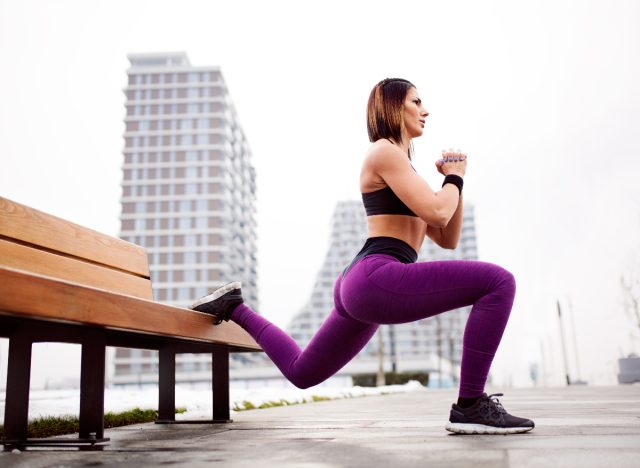From the growing popularity of fitness tracking apps to the rise of fitness influencers, there are countless exercise narratives being perpetuated—and some are more accurate than others. Among the many workout myths that persist, one type of exercise that often falls victim to misinformation is strength training. Despite its ability to support your heart health, protect your bones, and boost your mental health, this form of exercise is sometimes unnecessarily avoided because it’s misunderstood. Needless to say, there are some common strength training myths you should stop believing ASAP, which we’ll get into below.
To help us discern fact from fiction, we spoke with Chris Travis, a Seattle-based certified personal trainer, performance enhancement specialist, and fitness nutrition specialist. Read on to see what he has to say about these strength training myths. Then, for more workout insight, check out The 6 Best Exercises for Strong and Toned Arms in 2022, Trainer Says.


This is arguably one of the most common strength training myths. It’s also a fear Travis says he often hears about from his female clients. However, the expectation that this form of exercise will lead to a significant increase in muscle mass doesn’t translate to reality.
“I think this [myth] kind of emanated from bodybuilding culture in the 70s and 80s—especially when people like Arnold Schwarzenegger were out there, and the only thing you saw in gyms were these big, buff dudes doing bodybuilding exercises for two hours,” Travis says. “The thing that’s interesting about that is it’s really hard to build that kind of muscle. It takes a really long time. And it’s a really slow process.”
In order to build such notable body mass, one needs to eat a caloric surplus with a significant amount of protein in addition to working specific muscles for prolonged periods of time, Travis says. Although strength training can change your body’s physical appearance, it won’t be as apparent as you might expect.
“Most people are just eating normally, and so if that’s the case… your lean muscle mass is probably going to increase and your fat body mass is probably going to decrease,” he says. “So, you’re going to see some, probably, positive body comp[osition] changes in the process of doing that already—impact on mental health, physical health, chronic diseases, all of that stuff…”
Related: Get Rid of a Pot Belly in Your 50s With This 10-Minute Workout, Trainer Says


As the owner of Seattle Strength & Performance, Travis says the first core value at his gym is “Strength training is for everybody.” However, many people believe that strength training is geared toward younger or “fitter” individuals.
READ RELATED: NHS England waiting times for cancer referral and treatment at record high
This couldn’t be further from the truth, though. With strength training having a positive impact on bone density, this form of exercise is highly beneficial for seniors.
“If you can extend your quality of life into your 80s and 90s and still be able to actively move around, still be able to get up from a chair on your own, still be able to resist falls and stay balanced, and still have some flexibility and mobility—all of these things are critical just to life,” Travis says, “Especially as you get older, I would say anyone over 50: it’s a must-do.”
Related: The #1 Weight Training Workout To Reverse Aging After 40, Trainer Says


While strength training is known for its ability to enhance athletic performance and prevent injury, some runners believe that it’s not necessary or will even hinder their results.
“We get a lot of people [in the gym] who run, and they’ve been actively running for a long time in life, and then they come in and say, ‘Oh, I’ve always heard that strength training is bad for your running—that if you want to improve your running, you should just run more,” Travis says. “Certainly, you want to do sport-specific activities if you’re a runner, but at the same time, strength training complements running in a big way.”


If you’re a runner looking to incorporate strength training into your workout regimen, check out The Best Strength Training Exercises for Runners, Trainer Says.
Brianna Ruback
Source:







